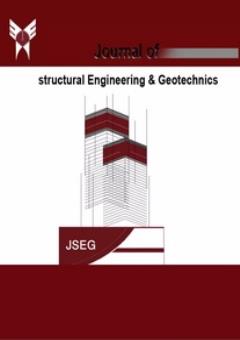Evaluation of the Collapse Fragility Curve of the Moment Resisting Steel Frames with Rigid and Semi-rigid Connections under Near-Field Earthquake Records
محورهای موضوعی : ایمنی زیستی
Arash Amiri Allahdehi
1
,
Ali Anvarsamarin
2
![]()
1 - Department of Civil Engineering, Qazvin Branch, Islamic Azad University, Qazvin, Iran
2 - Department of Civil Engineering, Qazvin Branch, Islamic Azad University, Qazvin, Iran
کلید واژه: Incremental dynamic analysis, collapse fragility curve, Endurance-Time Analysis, Rigid and Semi-Rigid Connection,
چکیده مقاله :
One of the major impacts of near-field earthquakes is a concentration of rupture on the limited number of stories and structural elements beyond the expected. Therefore, predicting the distribution of quantitative parameters of earthquake response at structural height can help to estimate the destructive potency of near-field earthquakes. In near-fault regions, directivity cause fling-step in the velocity time-history records, imposing more resistance and ductility requirements on the structure perpendicular to the fault line. The Endurance Time (ET) method is an innovative and straightforward method for dynamic loading and analysis of structures, apprehensible for the standard level of seismic engineering knowledge. The collapse performance and the accuracy of the ET in the seismic assessment of steel moment-resisting frames are discussed. Results of ET and IDA compared to observe the ET method’s potential benefits and drawbacks in the seismic evaluation of this category of frames. To model the semi-rigid connection to reduce flexural stiffness, the width of the upper and lower beam flanges were reduced and the results were analyzed. According to the obtained results, the reduction in rigidity percentage decreases the median of collapse capacities and increases the dispersion of IDA curves and seismic vulnerability of the building. Also, it was observed that the ET method overestimates the median of collapse capacity and leads to unsafe design.
1.Goulet, Christine A., Jennie WatsonLamprey, Jack Baker, Curt Haselton, and Nico Luco. "Assessment of ground motion
selection and modification (GMSM) methods for non-linear dynamic analyses of
structures." In Geotechnical Earthquake Engineering and Soil Dynamics IV, pp. 1-10. 2008.
2.Ambraseys, N. N., and J. Douglas. "Nearfield horizontal and vertical earthquake ground motions." Soil dynamics and
earthquake engineering 23, no. 1 (2003): 1-18.
3.Ben-Zion, Yehuda. "Dynamic ruptures in recent models of earthquake faults." Journal of the Mechanics and Physics of Solids 49,
no. 9 (2001): 2209-2244.
4.S. Shahbazi, I. Mansouri, J. W. Hu, and A.Karami, “Effect of soil classification on seismic behavior of SMFs considering soilstructure interaction and near-field earthquakes,” Shock and Vibration, vol.2018, Article ID 4193469, 17 pages,2018.View at: Publisher Site | Google Scholar
5.Bolt, B. A. (1975). „„San Fernando earthquake 1971. Magnitude, aftershocks and fault dynamics.‟‟ Chapter 21, Bulletin 196, California Division of Mines and Geology
6.Champion, Casey, and Abbie Liel. "The effect of near‐fault directivity on building seismic collapse risk." Earthquake Engineering & Structural Dynamics 41, no.10 (2012): 1391-1409.
7.AKBAŞ, BÜLENT, and Jay Shen. "Seismic behavior of steel buildings with combined rigid and semi-rigid frames." Turkish Journal of Engineering and Environmental Sciences 27, no. 4 (2003): 253-264.
8.Fariborz Farhadi; Ali Anvarsamarin. "Evaluation of Nonlinear Dynamic Response of Rigid and Semi-Rigid Steel Frames under Far-Field Earthquake
Records". Journal of Structural Engineering and Geo-Techniques, 9, 2, 2019.
9.Vamvatsikos, D. and Cornell, C.A. "Incremental dynamic analysis", Earthquake Engineering and Structural Dynamics, 31(3), 491-514. (2002).
10.Stoica, Maria, Ricardo A. Medina,and Richard H. McCuen. "Improved probabilistic quantification of drift demands for seismic evaluation." Structural Safety 29,no. 2, 132-145. (2007).
11.Anvarsamarin, Ali, Fayaz Rahimzadeh Rofooei, and Masoud Nekooei. "Soilstructure interaction effect on fragility curve of 3D models of concrete moment-resisting buildings." Shock and Vibration 2018 (2018).
12. Anvarsamarin, Ali, Fayaz Rahimzadeh Rofooei, and Masoud Nekooei. "Torsion Effect on the RC Structures using Fragility Curves Considering with Soil-Structure Interaction." Journal of Rehabilitation in Civil Engineering 8, no. 1 (2020): 1-21.
13.Zareian, Farzin, and Helmut Krawinkler."Assessment of probability of collapse and design for collapse safety." Earthquake Engineering & Structural Dynamics 36, no. 13 (2007): 1901-1914.
14.Estekanchi, H. E., A. Vafaei, and AZAR M. SADEGH. "Endurance time method for seismic analysis and design of structures."(2004): 361-370.
15.Estekanchi, H. E., V. Valamanesh, and A.Vafai. "Application of endurance time method in linear seismic
analysis." Engineering Structures 29, no. 10 (2007): 2551-2562.
16.Estekanchi, Homayoon E., and Mohammad Ch Basim. "Optimal damper placement in steel frames by the Endurance Time method." The Structural Design of Tall and Special Buildings 20, no. 5 (2011):612-630.
17.Federal Emergency Management Agency (FEMA). Quantifi cation of building seismic performance factors.
18.Report No. FEMA P695, Federal Emergency Management Agency,
Washington, DC, (2009).
19.ASCE 7-10, Minimum Design Loads for Buildings and Other Structures. American Society of Civil Engineers, Reston, VA,USA, (2010).
20.ETABS, Structural Analysis Program (2013). Computers and Structures Inc.Berkeley, California, U.S.A.
21.FEMA, A. 440, Improvement of nonlinear static seismic analysis procedures. FEMA-440, Redwood City, (2005).
22.Pacific Earthquake Engineering Research Center (PEER), PEER Next Generation Attenuation (NGA) Database, 2013, https://
ngawest2.berkeley.edu.
23.Ibarra, Luis F., and Helmut Krawinkler. Global collapse of frame structures under seismic excitations.Berkeley, CA: Pacific Earthquake Engineering Research Center, 2005.


